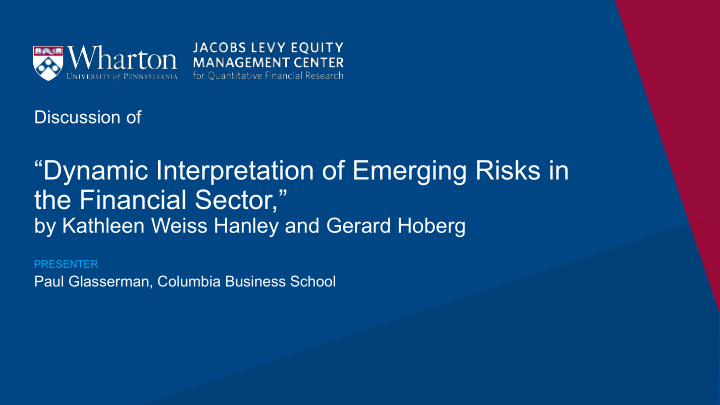



Discussion of “Dynamic Interpretation of Emerging Risks in the Financial Sector,” by Kathleen Weiss Hanley and Gerard Hoberg PRESENTER Paul Glasserman, Columbia Business School
Key Finding • Commonality in the risks disclosed by banks in their 10-Ks predicts comovements in their stock returns • As a corollary, greater commonality in disclosed risks potentially forecasts financial instability Important risks detected well in advance of 2008 Paper points to recent emerging risks • Risks are identified using novel application of natural language processing
Key Finding – II For individual banks, greater exposure to common disclosed risks predicts Lower stock returns Higher risk of failure Higher stock price volatility
Methodology • Paper uses state-of-the-art topic analysis techniques • A topic is a cluster of co-occurring words; clusters identified from 10-Ks • Interpreting and labeling topics is a bit of an art “foreclosure,” “property,” “deed,” etc., suggest “Real Estate” others are less obvious Innovative data science techniques have a lot to add in dealing with unstructured data • Authors are very careful to let the algorithms speak. Given the limited domain, additional intervention would be useful in separating and identifying topics
What is the Information Found in the 10-Ks? It’s unlikely that any one person read 500+ risk disclosures each year This is where new tools can help Paper finds that important risks (e.g., real estate related) were known in advance This sounds right – there was a lot of angst about a housing bubble in 2005 Google searches What if this paper had been available in 2005? Was the information already known?
The Paper’s Key Question And Answer Can text analysis be used to forecast market instability? Yes, many months ahead Harry Mamaysky and I ask the same question* and get the same answer We use the Thomson-Reuters news archive We find that an increase in “unusual” negative news forecasts an increase in volatility several months ahead * Does Unusual News Forecast Market Stress?
Two Questions for Both Papers 1. Do the text measures forecast market variables? 2. Is the information already in contemporaneous prices? If not, why not? For the second, we control for lagged volatility and negative returns We find less predictability at the single-stock level than the aggregate level Our interpretation: investors are quicker to incorporate information about individual stocks (consistent with what Jung and Shiller call “Samuelson’s Dictum”) Aggregate information in single-stock news is less accessible to individuals
Same Questions for this Paper Commonality in risks predicts return covariance How does this hold up if we include lagged covariance as a predictor? Greater exposure to common risks forecasts individual bank volatility What if we include lagged volatility? BUT, topic analysis of risks is useful even if forecasting power is reduced. It can provide a narrative (“Dynamic Interpretation”) to help interpret the sources of comovement – a valuable feature of topic modeling
Size Weighting? Analysis treats its 500-700 banks equally But aren’t we also concerned about common risks among the top 5-10? Trading-related risks don’t show up in larger group With so many small banks, I was surprised not to see “region” topics emerge or exposure to regional topics like energy For larger banks, would be interesting to see response in 5-year CDS spreads as well as quarterly stock returns to see if some risks are seen as having long-term consequences
Summary A very nice paper that combines • methodological innovation in dealing with unstructured data, clearly explained • a new perspective on forecasting financial instability • of interest to academics, practitioners, and regulators – useful addition to suite of systemic risk indicators
Recommend
More recommend